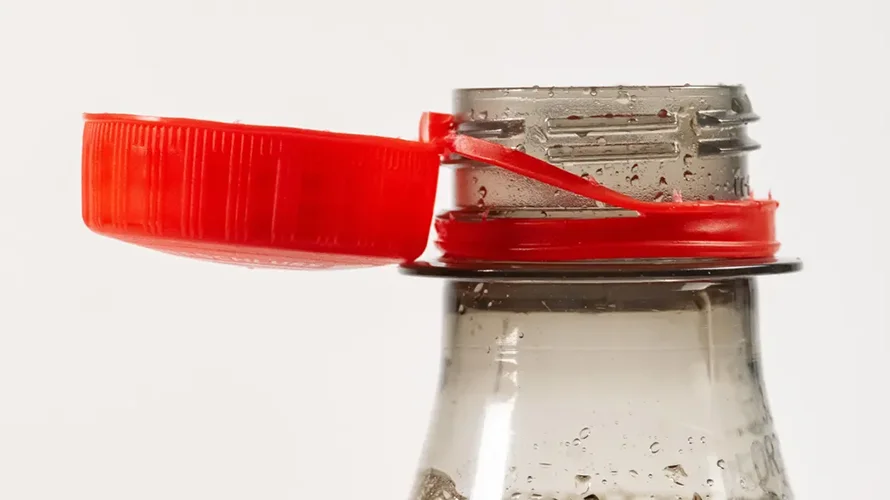A quick overview of the topics covered in this article.
Subscribe to the UKPACK newsletter to receive regular updates on the company, products, services, upcoming exhibitions and more.
Starting from summer 2024, all caps and lids on single-use plastic beverage containers with a capacity up to 3 liters must remain attached (tethered caps), as stipulated by the European Union’s Single-Use Plastics Directive 2019/904. With the full transition happening this year, consumers will become more accustomed to handling the new tethered cap system when drinking and pouring. The purpose of this transition is to ensure that single-use plastic drink containers with lids can re-enter the recycling stream.
Analyzing The Effects Of The New Regulation
Consumers will need to adjust to the new opening method for bottle caps, which may initially seem inconvenient. However, the tethered cap system is expected to have significant benefits:
- Greatly reduce plastic bottle cap pollution as the caps will no longer detach easily after opening.
- Avoid leakage of up to 1.3 billion plastic bottle caps per year into the environment, according to EU estimates, substantially reducing shoreline and beach litter.
- Ensure more single-use plastic drink bottles re-enter the recycling stream rather than potentially being discarded and adding to plastic waste pollution.
- Translate to less plastic waste leakage overall, reducing plastics in our rivers, lakes, and oceans.
- Help address the issue of plastic caps comprising a large percentage of shoreline litter that breaks down into hazardous microplastics over time.
- Decisively plug the leakage of bottle caps into the environment, as aimed by the new EU regulation.
- Make a meaningful difference in curbing non-degradable and hazardous plastic waste, according to experts, even if the exact impact remains to be quantified.
- Propel greater environmental responsibility around disposable plastics across industries, alongside changing consumer behavior.
Changes Expected From The New Regulation
The new tethered cap requirement is expected to usher in positive changes in the coming years when it comes to single-use plastic waste and recycling. Experts predict recycling rates of single-use plastic drink containers will increase substantially in EU countries following implementation of this regulation. By keeping caps attached, more plastic bottles are likely to enter recycling streams rather than be discarded in landfills or nature after use. With higher collection and processing with caps reattached, the quality and economic value of recycled single-use plastic will also increase over the long term.
In turn, the amount of plastic waste pollution in rivers, lakes, beaches and oceans could considerably reduce as less plastic ends up in the environment. Researchers estimate over 5 billion plastic bottles are littered yearly in the EU, a figure that may now plateau or decline. Campaigners also emphasize that stemming the tide of plastic cap litter is crucial since they tend to break down into hazardous microplastics that persist for centuries. Tackling this via tethered caps is a vital step.
Most importantly, the new rules underscore EU’s commitment to mitigating plastic pollution and transitioning to a circular economy model for plastics use. They represent real movement from pledges to actionable legislation that can transform manufacturing habits and consumer behavior at scale. The success of these cap regulations will likely motivate setting of more ambitious plastic waste recycling targets for EU states to work towards. Many observe this as a landmark moment in Europe’s fight against the scourge of non-biodegradable plastic trash.
Active Response From All Stakeholders
Achieving the goals of reduced plastic waste and higher recycling rates requires proactive response and commitments across the spectrum – from businesses to policymakers to consumers:
Industry players must ramp up product design and production lines for the new tethered cap and container systems well before the 2024 regulatory deadline. Trade associations can provide technical guidance while packaging manufacturers need to invest in suitable bottle cap molding equipment and quality testing measures. Firms will also need to bear costs for back-collecting and processing more recycled plastic.
At the government level, EU states must bolster funding mechanisms that underwrite the buildout of plastic sorting and recycling infrastructure. Tax incentives can further catalyze corporate investments into improved collection logistics and upgraded facilities to handle greater recyclable material volumes. Stronger regulations are also required to ensure transparency and reporting by companies on plastic waste generation.
Lastly, European consumers have to become more discerning regarding responsible plastic use when making purchasing choices. Proper separation of tethered cap bottles, pods and pouches for recycling can make a tangible difference. Through individual actions like avoiding littering and minimizing reliance on single-use plastics for food and drinks, citizens can complement top-down policy efforts to drive change.
The regulations present a collaborative opportunity to combat plastic waste – one that policymakers, businesses and consumers need to firmly embrace in the coming years.
Conclusion
In closing, the single-use plastics directive on attached caps and lids marks a watershed moment for Europe to lead the global fight against plastic pollution while enabling the growth of a circular economic model. With projections indicating effective waste reduction and boosted recycling from these regulations, it brings the continent closer to the vision of minimized plastic leakage into nature and maximized reuse of plastic resources.
The enforcement of such sweeping rules also reinforces Europe’s place as a pioneer in sustainable legislation and environmental stewardship. As the world’s second biggest producer of plastics, the EU is taking ownership of this issue through firm policy action. The success of these interventions will likely motivate more countries to follow suit with stringent measures to combat non-recyclable plastic trash.
Most vitally, the tethered cap requirements illuminate the tremendous impact even small product redesigns can engender for the good of the planet. We inch closer to the goals of curbed plastic waste flooding our rivers and beaches, lowered reliance on fossil-fuel based virgin plastics, and establishing a circular lifecycle for used polymers. And Europe leads the way in crafting pragmatic frameworks to realize this vision.

Lucas Ji, Founder of UKPACK and Chief Packaging Designer, has 15 years of experience designing sustainable packaging for global beauty and beverage brands. His Red Dot Award-winning solutions have helped 50+ premium brands transition to eco-friendly packaging.

